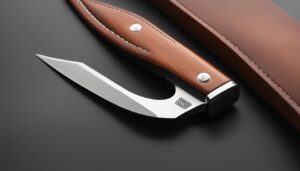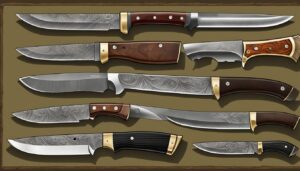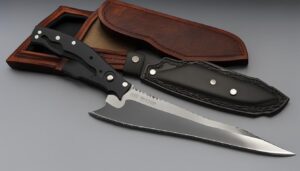The history and evolution of knives can be traced back to ancient civilizations, where early humans crafted rudimentary cutting tools using stone, bone, and other natural materials. Over time, knives have evolved to become essential companions in various aspects of our lives, including hunting. To ensure the longevity and peak performance of your traditional hunting knives, it is crucial to follow proper maintenance and care techniques. This article will provide you with essential tips and guidelines for caring for your traditional hunting knives.
Key Takeaways:
- Regularly clean your hunting knife after each use to remove debris and prevent rust formation.
- Store your hunting knives in a dry and secure place, preferably inside a sheath or knife roll.
- Choose the right hunting knife based on the intended use, blade length, handle comfort, and balance.
- Sharpen your hunting knife using electric sharpeners or manual sharpeners like handheld sharpeners or sharpening stones.
- Regularly check and oil the blades to prevent corrosion and maintain optimal cutting performance.
Tips for Choosing the Right Hunting Knife
When it comes to selecting a hunting knife, there are several factors to consider that will ensure you find the right tool for the job. Here are some tips to help you choose the perfect hunting knife:
- Intended Use: Determine the primary purpose of the knife. Will you be using it for skinning, gutting, or boning? Different tasks may require different blade styles, such as drop point, clip point, or gut hook.
- Blade Length: Consider the ideal blade length for your needs. Longer blades are suitable for slicing and chopping, while shorter blades excel in tasks that require precision and control.
- Handle Comfort and Grip: Ensure that the knife’s handle is comfortable to hold and provides a secure grip. Look for handles made of materials like wood, rubber, or textured synthetic materials for enhanced grip.
- Weight and Balance: Find a knife that feels balanced and comfortable in your hand. Weight and balance can greatly affect the knife’s usability and ease of handling.
- Blade Thickness: Consider the thickness of the blade. Thicker blades are more durable and suitable for heavy-duty tasks, while thinner blades offer finer cutting capabilities.
By considering these factors, you can choose a hunting knife that meets your specific needs and ensures a successful hunting experience.
Tips for Choosing the Right Hunting Knife
“The right hunting knife can make all the difference in your outdoor adventures. Take the time to choose a knife that suits your needs and preferences. Remember, a well-chosen knife is a reliable companion in the wilderness.”
Now that you have a better understanding of the factors to consider when choosing a hunting knife, you can make an informed decision and select the perfect tool for your outdoor pursuits. Remember to prioritize your intended use, blade length, handle comfort and grip, weight and balance, and blade thickness. With the right hunting knife in hand, you’ll be well-prepared for any hunting expedition.
| Factor | Suggested Blade Style |
|---|---|
| Skinning | Gut Hook |
| Gutting | Drop Point |
| Boning | Clip Point |
Table: Suggested Blade Styles for Different Hunting Tasks
Proper Cleaning and Storage Techniques
Proper cleaning and storage techniques are essential for maintaining the longevity and performance of your traditional hunting knives. Taking care of your knives after each use will ensure that they remain sharp, rust-free, and ready for your next hunting adventure.
1. Cleaning Your Hunting Knife
After using your hunting knife, it is important to clean it thoroughly to remove any dirt, debris, or residue. To clean your knife:
- Rinse the blade with warm soapy water, using a soft cloth or sponge to gently scrub away any grime.
- Avoid using abrasive cleaners or steel wool, as they can damage the blade’s finish.
- Pay special attention to the handle, ensuring that it is also clean and free from any dirt or moisture.
- Dry the knife completely with a clean, absorbent cloth to prevent the formation of rust.
By following these cleaning steps, you will not only keep your hunting knife in great condition but also prevent any unwanted odors or contamination.
2. Proper Storage for Your Hunting Knife
Storing your hunting knife properly is just as important as cleaning it. Here are some tips for storing your knife:
- Store your hunting knife in a dry and secure place to prevent exposure to moisture, which can lead to rust.
- Consider using a sheath or knife roll to protect the blade from physical damage and to keep it safely stored away.
- Avoid storing your knife in extreme temperatures, as this can affect its performance and durability.
- Regularly check your stored knife for any signs of rust or damage and address them promptly to prevent further issues.
By following these storage techniques, you can ensure that your hunting knife remains in optimal condition, ready for your next outdoor expedition.
Remember, proper cleaning and storage are essential for maintaining the performance and longevity of your traditional hunting knives. By incorporating these tips into your knife care routine, you can enjoy years of reliable use and make the most out of your hunting experience.
Honing Your Hunting Knife to Perfection
As a dedicated hunting enthusiast, I understand the importance of maintaining a sharp and reliable hunting knife. Honing your hunting knife is an essential part of its maintenance routine, as it helps to restore and maintain the edge for optimal cutting performance. Whether you prefer an electric sharpener or a honing rod, there are a few key techniques to keep in mind.
The Electric Sharpener Advantage
An electric sharpener is a popular choice among hunters due to its speed and convenience. It utilizes rotating abrasive wheels to quickly restore the edge of a dull blade. However, it’s crucial to exercise caution while using an electric sharpener, as too much pressure or excessive passes can remove excessive amounts of metal, affecting the knife’s balance and longevity. Remember to follow the manufacturer’s instructions and practice proper technique for the best results.

The Art of Honing
If you prefer a more traditional approach, honing your hunting knife with a honing rod or sharpening steel is an excellent choice. This technique helps to realign the edge of the blade and maintain its sharpness. When honing your knife, hold the rod at a slight angle and swipe the blade across the rod, alternating sides with each stroke. Remember to maintain a consistent angle and apply gentle pressure. Regular honing sessions will keep your hunting knife in top condition for extended periods of time.
Remember, honing and sharpening are not the same. While honing maintains the sharpness of a blade, sharpening involves removing metal to create a new edge. It’s essential to strike the right balance between the two to ensure the longevity of your hunting knife.
Conclusion: Longevity and Performance for Your Traditional Hunting Knives
Proper maintenance is crucial for ensuring the longevity and performance of your traditional hunting knives. By following the tips and techniques outlined in this article, you can keep your knives sharp, rust-free, and ready for your outdoor adventures.
First and foremost, make sure to choose the right hunting knife for your specific needs. Consider factors such as intended use, blade length, handle comfort, and balance to ensure you have the perfect tool for the job.
In addition, proper cleaning and storage are essential. Clean your hunting knives after each use using warm soapy water and a soft cloth, and be sure to dry them thoroughly to prevent rust formation. Store your knives in a dry and secure place, ideally inside a sheath or knife roll, to protect them from moisture and physical damage.
Lastly, don’t forget to regularly sharpen and hone your hunting knife. Whether you prefer using electric sharpeners for convenience or manual sharpeners for precision, maintaining a sharp edge is vital for optimal cutting performance.
By taking these steps to care for your traditional hunting knives, you can ensure their longevity and performance, allowing you to enjoy many successful hunting trips for years to come.
FAQ
How do I choose the right hunting knife?
When choosing a hunting knife, consider factors such as the intended use, blade length, handle comfort and grip, weight and balance, and blade thickness.
How should I clean and store my hunting knife?
After each use, clean the knife with warm soapy water and a soft cloth, avoiding abrasive cleaners or steel wool. Dry the knife thoroughly and store it in a dry and secure place, preferably inside a sheath or knife roll.
How do I sharpen my hunting knife?
You can sharpen your hunting knife using electric sharpeners, manual sharpeners such as handheld sharpeners or sharpening stones, or honing rods. Regularly check and sharpen the blade as needed.
Why is proper maintenance important for hunting knives?
Proper maintenance ensures the longevity and performance of your hunting knives, keeping them sharp, rust-free, and ready for outdoor adventures.
Source Links
- https://www.uniqueblade.com/pages/ebook-ultimate-guide-to-knives-a-comprehensive-handbook-for-knife-enthusiats
- https://www.williamhenry.com/wh-insider/how-to-sharpen-a-pocket-knife/
- https://www.dick.de/fileadmin/user_upload/downloads/messerbroschueren_en/9800055_care_instructions___guideline_knives___sharpening_steels_engl.pdf





